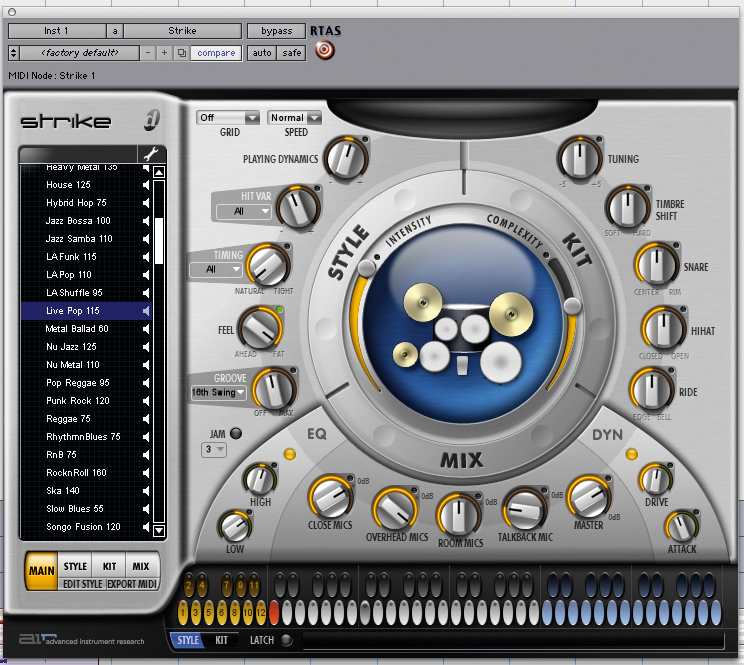MusicRadar Verdict
Strike is far more powerful and complex than it first appears. Once you get under its skin, it becomes an extremely useful plug-in.
Pros
- +
Very flexible. Easy to get started. Kit sounds are good. Doesn't eat up hard drive space. Everything happens within the plug-in interface.
Cons
- -
For Pro Tools users only. Library could be more extensive.
MusicRadar's got your back
Not so long ago, if you wanted real-sounding drums, you had to get a real drummer to play them.
Unfortunately, that also meant a real studio, real equipment and - worst of all - real money. But thanks to a few groundbreaking bits of software (notably FXpansion's BFD and Toontrack's DFH Superior), things have changed forever.
When it comes to creating software instruments, no one could accuse Digidesign of being ahead of the game. However, now that they've jumped on board the bandwagon, the products are coming thick and fast.
For their third instrument (Hybrid and Xpand! being the first two), they've pulled out all the stops to produce Strike, "The Ultimate Virtual Drummer".
Overview
Like a number of 'virtual player' plug-ins, Strike is a combination of two elements: a sound library and a pattern library.
It comes on two DVDs (thanks to lossless data compression, the 20GB 24-bit library takes up only 5GB of disk space) and is designed to help you program real-sounding drums.
There are five drum kits (each of which boasts up to 12 separate sounds), 1500 patterns, built-in EQ and dynamics, and an audio mixer.
Want all the hottest music and gear news, reviews, deals, features and more, direct to your inbox? Sign up here.
On the face of it - and given the compact library - Strike initially looks pretty simplistic. However, looks can be deceiving; scratch the surface and this reveals itself to be a very serious plug-in indeed.
With each drum hit generating up to seven channels of audio, you can quite easily find that you've got 100 channels of drum-based audio running simultaneously. Not bad for one instance of a plug-in!
Surprisingly, though, it's the pattern side of Strike that's the more complex facet. With full editing access to the onboard patterns, the sky's the limit. What's more, you can export
your noodlings to a series of individual MIDI tracks for extra editing (or so that they can be used to trigger other sounds).
Inevitably, this power and flexibility makes Strike quite a complex plug-in to get to grips with, so here's the lowdown on how it hangs together.
The main presets are called 'Settings' and include everything from a drum kit type to an overall style (anything from bebop to West coast funk).
Within the style, you'll find a whole load of patterns, including verses, choruses and fills. These are mapped across the white keys on the keyboard at the bottom of the screen (the blue keys trigger single hits and the yellow keys act as mutes).
The main window is divided into three sections - Style, Kit and Mix - and each of these has some fundamental controls that affect the overall performance.
In the Style section these are concerned with playing dynamics, timing and hit variation, whereas in the Kit section they're more to do with sound (tuning, timbre and variation).
The Mix section includes overall levels for the dry kit and ambience mics, plus basic EQ and dynamics.
Finally, there are a couple of sliders in the middle of the interface that control the overall intensity and complexity of the playing.
But as we've already mentioned, Strike is a serious plug-in, and the Style, Kit and Mix sections also have their own separate windows.
Here, you'll find plenty more to keep you busy, including hit-specific parameters for both styles and sounds, a full-on mixer with EQ and two further selectable inserts for each channel.
Easy to use
Fortunately, once you get to grips with its basic concepts, Strike becomes incredibly easy to use.
Whether you choose to play the pads on screen or via MIDI, the preset patterns enable you to get a groove up and running very quickly.
If you want to program a part sound-by-sound from scratch, you can do that too, but the real beauty of Strike lies in its ability to let you do a bit of both.
If you begin by using preset patterns to get things moving, it's then really simple to go in and edit things to taste. And of course, everything can be done from within the plug-in (including EQ and dynamics adjustments).
On the downside, Strike does seem to have a very specific way of doing things, so if you approach it with your own ideas of what you want in terms of sound, you may find it to be a little restrictive.
This is primarily because the core sound set, although excellent, isn't as extensive as some others we've encountered.
In fact, after you've loaded a number of different styles, you'll notice that some of the sounds are 'recycled'.
This is a bit of a shame; it would be good to see Strike's library expanded in the future, particularly with more kicks, snares and hi-hats.
Ultimately, though, this slight limitation shouldn't detract too much from what is a very powerful, reliable and fundamentally quick-to-use instrument, and one that's sure to make non-Pro Tools users just a little bit jealous.
Computer Music magazine is the world’s best selling publication dedicated solely to making great music with your Mac or PC computer. Each issue it brings its lucky readers the best in cutting-edge tutorials, need-to-know, expert software reviews and even all the tools you actually need to make great music today, courtesy of our legendary CM Plugin Suite.

